Giới thiệu:
UNIT 12 THE STEERING SYSTEM
Mã bài: MH09-12
Trong bài này sinh viên được cung cấp một số thuật ngữ cơ bản liên quan đến các chi tiết cấu tạo của hệ thống đánh lái trên xe ô tô. Sinh viên đọc hiểu bài khóa nói về các chi tiết cấu tạo của hệ thống đánh lái và thực hành các bài tập để rèn luyện kỹ năng đọc hiểu.
Mục tiêu:
- Kiến thức:
+ Nhận biết các thuật ngữ cơ bản liên quan đến các các chi tiết cấu tạo của hệ thống đánh lái như vô lăng, ro-tuyn, đầu ro-tuyn trong/ngoài, thanh giằng, cùm bánh, rô-tuyn chuyển hướng, rô-tuyn trụ, ổ trục, hộp lái...
+ Hiểu được nội dung chính của bài khóa tiếng Anh nói về chi tiết cấu tạo của của hệ thống đánh lái trên xe ô tô.
- Kỹ năng:
+ Đọc hiểu được nội dung bài khóa tiếng Anh nói về chi tiết cấu tạo của của hệ thống đánh lái trên xe ô tô.
- Năng lực tự chủ và trách nhiệm:
+ Phát triển khả năng làm việc độc lập và làm việc theo cặp/nhóm.
+ Tự đánh giá kết quả của bản thân hoặc của các thành viên trong cặp/nhóm sau khi hoàn thành bài tập.
THE STEERING SYSTEM
The steering system consists of a series of linkages and gears that link the driver to the wheels. Two types of steering systems that are in use today are rack- and-pinion and parallelogram. The older parallelogram linkage system is still found on some cars and trucks. The parallelogram includes a frame-mounted steering gearbox, pitman arm, idler arm, inner and outer tie-rod ends. The parallelogram system has the most grease fittings.
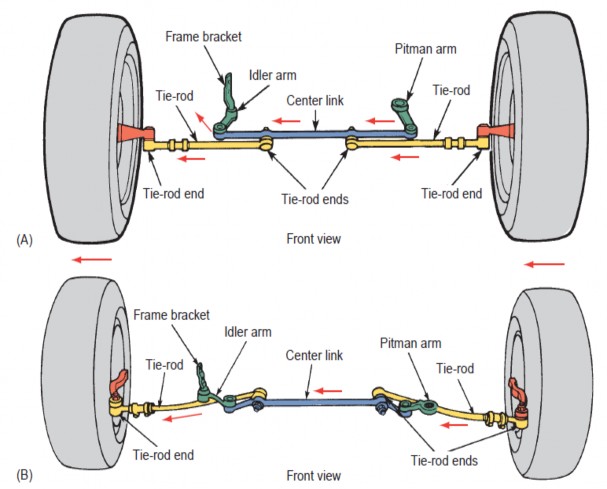
Figure 12.1 Parallelogram steering system mounts (A) behind the front suspension, and (B) ahead of the front suspension system
Rack and pinion is lighter in weight and has fewer components than parallelogram steering. Tie rods are used in the same fashion on both systems, but the resemblance stops there. Steering input is received from a pinion gear attached to the steering column. This gear moves a toothed rack that is attached to the tie-rods. In the rack and pinion steering arrangement, there is no pitman arm, idler arm assembly, or center link. The rack performs the task of the center link. Its movement pushes and pulls the tie-rods to change the wheel’s direction. The tie-rods are the only steering linkage parts used in a rack and pinion system.
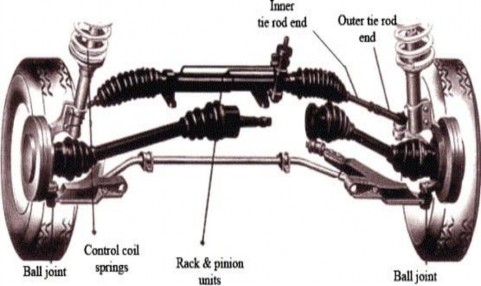
Figure 12.2 Rack & pinion steering system
The steering linkage
The steering linkage is the part of steering systemthat connects the steeringwheelto the front wheels. When you turn your steering wheel, the steering linkage causes your front wheels to respond by moving in the proper direction.
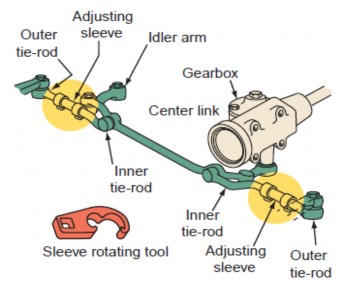
Tie-rod ends
Figure 12.3 Tie-rod assembly |
Có thể bạn quan tâm!
-
 A Very Thin Oil Called Transmission Fluid Fills The Transmission System And Generates Hydraulic Pressure. As The Engine Speed Changes, The Pump That Pumps The Transmission Fluid To Develop
A Very Thin Oil Called Transmission Fluid Fills The Transmission System And Generates Hydraulic Pressure. As The Engine Speed Changes, The Pump That Pumps The Transmission Fluid To Develop -
 Anh văn chuyên ngành Nghề Công nghệ ô tô - CĐ TC - Trường Cao đẳng nghề Đồng Tháp - 8
Anh văn chuyên ngành Nghề Công nghệ ô tô - CĐ TC - Trường Cao đẳng nghề Đồng Tháp - 8 -
 Anh văn chuyên ngành Nghề Công nghệ ô tô - CĐ TC - Trường Cao đẳng nghề Đồng Tháp - 9
Anh văn chuyên ngành Nghề Công nghệ ô tô - CĐ TC - Trường Cao đẳng nghề Đồng Tháp - 9 -
 Anh văn chuyên ngành Nghề Công nghệ ô tô - CĐ TC - Trường Cao đẳng nghề Đồng Tháp - 11
Anh văn chuyên ngành Nghề Công nghệ ô tô - CĐ TC - Trường Cao đẳng nghề Đồng Tháp - 11 -
 Anh văn chuyên ngành Nghề Công nghệ ô tô - CĐ TC - Trường Cao đẳng nghề Đồng Tháp - 12
Anh văn chuyên ngành Nghề Công nghệ ô tô - CĐ TC - Trường Cao đẳng nghề Đồng Tháp - 12
Xem toàn bộ 97 trang tài liệu này.
Ball joints
Ball joints are important parts of the steering systems on all vehicles. A ball joint attaches the steering knuckle to the suspension system. The ball joint allows for pivotal and rotational movement of the wheel as it moves up and down and is steered left to right.
The steering linkage connects to the wheels. The wheels are held in place by a spindle that goes through the wheel and is attached to upper and lower control arms. The control arms allow the wheels to turn in any direction. To keep things moving
freely, ball joints are located at the points on the control arms where the movement takes place.
Most ball joints and tie-rod ends are filled with greaseto cut down on friction and keep the parts they protect from wearing away prematurely. Some vehicles have lifetime lubrication systems that are designed to operate for the life of the vehicle without the need for additional lubrication. Others need to be replenished with grease periodically.
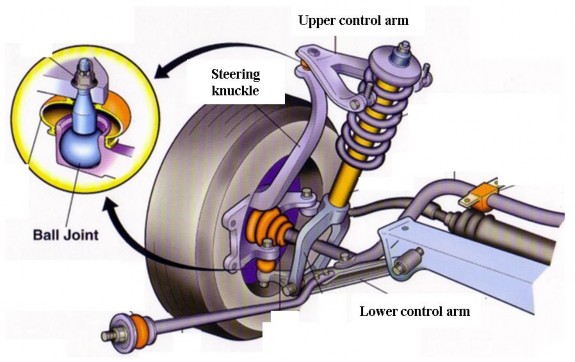
Figure 12.4 Ball joint and control arms
Task 1 Match the underlined word in the text with the correct definitions
1. the equipment in a vehicle that you use to control the direction it goes in 2. the wheel that the driver turns to control the direction that a vehicle goes in 3. a place where two or more parts of an object are joined together 4. a device that links two or more things 5. thick oily substance, especially one that is used to make machines run smoothly 6. a metal frame in the parallelogram steering system that often has the shape of letter A. 7. the part of a car or other vehicle that the steering wheel is fitted on |
Task 2 Read the text and circle the correct answers
1. There are a lot of …………in a steering system to link the driver to the wheels.
A-linkages B-gears C-linkages and gears
2. The steering wheel is linked to …….by using a steering linkage A-front wheel B-rear wheel C-front and rear wheel
3. At the place where two parts of the steering linkage meet, there is a …… A-ball socket B-tie-rod end C-both A and B
4. The suspension system is connected to the steering knuckle thanks to a
…………….
A-ball joint B-tie-rod end C-steering linkage
5. The wheels can turn in any directions thanks to the…………. A-steering linkage B-spindle C-control arms
6. Most ball joints and tie-rod ends have …………to reduce the friction. A-rubber bushings B-grease C-both A and B
Task 3 Read the text again and write short answers for these questions
1. How many types of steering systems are there? What are they?
…………………………………………………………………………………
2. Which has more grease fittings, parallelogram or rack and pinion steering system?
………………………………………………………………………………..
3. Which heavier in weight and has more components, parallelogram or rack and pinion steering system?
…………………………………………………………………………………
4. What causes the front wheels to respond and move in proper direction when you turn the steering wheel?
…………………………………………………………………………………
5. What helps the wheels to move pivotally and rotationally?
…………………………………………………………………………………
6. Where are ball joints located to keep things moving freely?
…………………………………………………………………………………
Task 4 Fill in each blank with a suitable word or phrase
steering knuckles outer tie-rod center link pinion meshes inner tie-rod
1. Tie-rods are actually assemblies that make the final connections between the steering linkage and steering knuckles. They consist of ………… ends and outer tie-rod ends. Inner tie-rod ends are connected to the opposite sides of the center link and ……………. ends connect to the
……………...
2. The idler arm is normally attached, on the opposite side of the……………., from the pitman arm and to the car frame, supporting the center link at the correct height.
3. The rack ……………..with the teeth of a small ………..at the end of the steering column. The two inner tie-rod ends, which are attached to the rack, are covered by rubber boots that protect the rack from contamination.
Vocabulary
+replenish (v) bổ sung, cung cấp thêm +sealed (a) được bít kín, khít +internal rubber bushing (n) ống cao su trong +cushion (v) làm dịu đi +wear away (v) làm mòn +spindle (n) trục quay +go through (v) đi xuyên qua +turn in any direction (v) xoay theo bất cứ chiều nào +control arm (n) càng A, thanh giằng +ball socket (n) khớp nối cầu +a series of (n) một loạt +respond (v) phản ứng, trả lời +move (v) di chuyển +proper direction (n) đúng hướng +grease (n) mở (bôi trơn) +lifetime lubrication system (n) hệ thống bôi trơn vĩnh viễn +lubrication (n) sự bôi trơn +periodically (adv) định kỳ |
Giới thiệu:
UNIT 13 THE SUSPENSION SYSTEM
Mã bài: MH09-13
Trong bài này sinh viên được cung cấp một số thuật ngữ cơ bản liên quan đến các chi tiết cấu tạo của hệ thống treo trên xe ô tô. Sinh viên đọc hiểu bài khóa nói về các chi tiết cấu tạo của hệ thống treo và thực hành các bài tập để rèn luyện kỹ năng đọc hiểu.
Mục tiêu:
- Kiến thức:
+ Nhận biết các thuật ngữ cơ bản liên quan đến các các chi tiết cấu tạo của hệ thống treo như thanh treo, càng A, thanh liên kết, thanh cân bằng, phuộc nhún, các loại lò xo...
+ Hiểu được nội dung chính của bài khóa tiếng Anh nói về chi tiết cấu tạo của của hệ thống treo trên xe ô tô.
- Kỹ năng:
+ Đọc hiểu được nội dung bài khóa tiếng Anh nói về chi tiết cấu tạo của của hệ thống treo trên xe ô tô.
- Năng lực tự chủ và trách nhiệm:
+ Phát triển khả năng làm việc độc lập và làm việc theo cặp/nhóm.
+ Tự đánh giá kết quả của bản thân hoặc của các thành viên trong cặp/nhóm sau khi hoàn thành bài tập.
THE SUSPENSION SYSTEM
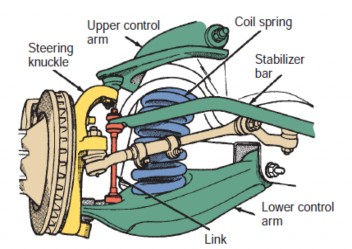
Most cars have independent front suspension systems. In that type of system each wheel is attached separately and can move independent of the others. Two common suspension systems are double-wishbone suspensions and Macpherson strut suspension.
Figure 13.1 A double-wishbone suspension |
MacPherson strut suspension: there are 2 types of strut suspensions: conventional and modified. Conventional struts have the coil spring wrapped around the strut cartridge, and the modified strut suspensions have a remotely mounted spring. Strut suspensions use no upper control arm. The upper strut mount is what holds the wheel in place. |
Figure 13.2 A MacPherson strut suspension |
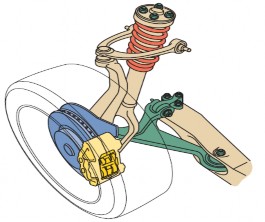
SUSPENSION SYSTEM COMPONENTS
Control arms
Control arms are sometimes referred to as A arms or A frames. The upper and lower control arms on the traditional independent front suspension (IFS) function primarily as locators. They fix the position of the system and its components relative to the vehicle and are attached to the frame with bushings that permit the wheel assemblies to move up and down separately in response to irregularities in the road surface. The outer ends are connected to the wheel assembly with ball joints inserted through each arm into the steering knuckle.
There are two types of control arms: the wishbone, or double-pivot, control arm and the single-pivot, or single-bushing, control arm. The wishbone offers greater





